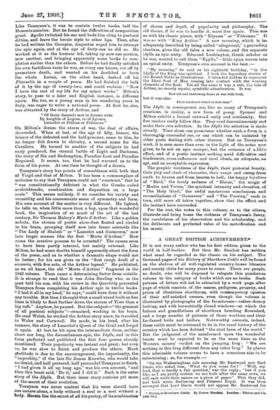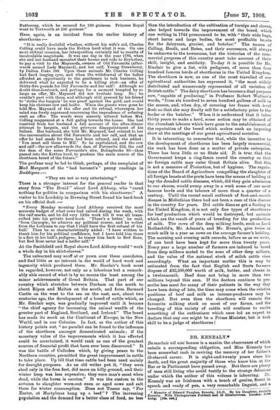A GREAT BRITISH ACHIEVEMENTi&
IT is not every author who has his first edition given to the world in half-leather. But then Mr. Sinclair has vnitten what must be regarded as the classic on his subject. The thousand pages of his History of Shorthorn Cattle wilt be found on the shelves of all well-regulated country-house libraries and county clubs for many years to come. There are people, no doubt, who will be disposed to relegate this ponderous volume to the category of books which are no books. Bush patrons of letters will not be attracted by a work page, after page of which consists of, the names, pedigrees, progeny, and prices of illustrious shorthorns, with contemporary opinion of their self-satisfied owners, even, though the volume is illustrated by photographs of the farmhouaes—rather dreary looking, and with hermetically closed windows—at which the fathers and grandfathers of shorthorn breeding flourished, and a large number of pictures of those worthies and their far-famed bulls and heifers. Noteworthy animals, indeed, these cattle must be esteemed to be in the rural history of the country which has been dubbed "the stud farm of the world." But the judgment of the uninformed upon the wonderful beasts must be expected to be on the same lines as. the Western miners' verdict on the jumping frog : " We see nothing in this frog different from any other frog." In places this admirable volume seems to have a conscious aim to be entertaining ; as, for example :- "On the Walkeringham sale morning Mr. Eastwood met Earl Duple, who asked him, 'What do you come for ? " Well, my lord, that is hardly a fair question,' was the reply ; but if you like, as I am pretty certain we are both after the same cows, we will each write their names on a piece of paper.' This they did, and both wrote Buttercup and Princess BoyaL It was then arranged that Lord Lucie would not oppose Mr. Eastwood for • History of Shorthorn Catils. By, James Sinclair. London : Vinton and CO. [Sila. 6d.]
Buttercup, which he secured for 130 guineas. Princess Royal went to Tortworth at 230 guineas."
Here, again, is an incident from the earlier history of short horns :— " It is really doubtful whether, without his wife's aid, Charles Coiling could have made the Ketton herd what it was. On one most critical occasion, her interposition certainly led to results of incalculable magnitude. It was one day in the year 1785, when she and her husband mounted their horses and rode to Eryholme, to pay a visit to the Maynards, owners of Old Favourite (after- wards named Lady Maynard), and her calf, Young Strawberry, by Dalton Duke 188. Upon these animals Mr. Charles Coiling had fixed longing eyes, and when the withdrawal of the ladies afforded an opportunity to the gentlemen to talk business, he delivered what ho expected to be a killing shot—an offer of thirty-five pounds for Old Favourite and her calf ! Although no doubt thunderstruck, and perhaps for a moment tempted by so large an offer, Mr. Maynard did not hesitate long. No; he couldn't part with them, and although still pressed by his friend to 'strike the bargain' he was proof against the gold, and would keep his choicest cow and heifer. When the guests were gone he told Mrs. Maynard of the offer and its refusal, whereupon her mind was freely expressed concerning the imprudence of refusing such an offer. The words were scarcely uttered before Mrs. Coiling reappeared at a full gallop towards the house. She had received from her husband a full account of the after-dinner attempt to bargain, and the grievous disappointment of his failure. Her husband, she told Mr. Maynard, had related to her the conversation about Old Favourite and her calf, and that an offer he had made for them had been refused, and she added : Yon must sell them to ME.' So he capitulated, and the cow and calf—the cow afterwards the dam of Favourite 252, the calf the dam of the same Favourite's sire, Bolingbroke 88—thus passed into the Ketton herd, to produce the main source of the shorthorn breed of the future."
The profane may be led to think, perhaps, of the complaint of Mad Margaret of the "bad baronet's" penny readings in Buddigore :— "They are not so very entertaining."
There is a stronger interest for the general reader in that story from "The Druid" about Lord Althorp, who "cared nothing for politics in comparison with his shorthorns." A visitor to his Lordship in Downing Street found his herd-book on his official desk :— "Every Monday morning Lord Althorp received the most accurate budget of what cows had calved during the week, with the calf marks, and he did very little work till it was U trans- cribed into his private herd-book. There's a letter,' he said, 'from Carnegie; he admires my political course, and he writes from the Lothians to say that I shall have the first refusal of his
bull.' Then he so characteristically added : have written to thank him for his political confidence, but I have told him there is a flaw in his bull's pedigree; he traces him back to Red Rose, but Red Rose never had a heifer calf.'"
At the Smithfield and Royal shows Lord Althorp would" work a whole day in his shirt-sleeves."
The unlearned may scoff at or yawn over these anecdotes, and find little or no interest in the world of hard work and ingenuity which produced them. Mr. Sinclair's book must be regarded, however, not only as a laborious but a remark- ably able record of what is by no means the least among the minor achievements of Great Britain. That part of our country which stretches between Durham on the north to 'about Ripon and Mallon on the south, and from Barnard Castle on the west to the sea on the east, saw, about two centuries ago, the development of a breed of cattle which, as Mr. Sinclair says, was gradually improved until it became " the chief agency for increasing the animal wealth of the greater part of England, Scotland, and Ireland." The breed Las made its mark on the Continent of Europe, in the New World, and in our Colonies. In fact, as the author of this history points out, "no parallel can be found to the influence of the shorthorn amongst domesticated animals ; if the monetary value of the improvements which it has effected
could be ascertained, it would rank as one of the greatest sources of financial profit that have ever been discovered." It was the battle of Culloden which, by giving peace to the Northern counties, permitted the great improvement in cattle to take place. Up till that time cattle had been used mainly for draught purposes. As an old writer put it, "they were shod only in the fore feet, did more on hilly ground, and their winter keep was less expensive; they were man's meat when dead, while the horse is carrion." It was the custom in the autumn to slaughter worn-out oxen or aged cows and salt 'them for winter consumption. Does not Tosser say, "For Easter, at Martylmas hang up a beef" P The increasing population and the demand for a better class of food, no less than the introduction of the cultivation of turnips and clover, also helped towards the improvement of the breed, which one writing in 1744 pronounced to be, with "their wide bags, short horns and large bodies, the most profitable beasts for the dairyman, grazier, and butcher." The names of Coiling, Booth, and Bates, and their successors, will always be unknown to the townsman, but the historian of the com- mercial progress of this country must take account of their skill, insight, and assiduity. To-day it is possible for Mr. Sinclair to give a list, with pedigrees, of more than four hundred famous herds of shorthorns in the United Kingdom. The shorthorn is now, as one of the most travelled of our agricultural authorities has expressed it, "the most widely distributed and numerously represented of all varieties of British cattle." The dairy shorthorn has hecome a dual purpose cow, "capable of producing," in Professor Robert Wallace's words, "from six hundred to seven hundred gallons of milk in
• the season, and, when dry, of covering her frame with level flesh so that she may finally sell for a satisfactory price to the feeder or the butcher." When it is understood that it takes thirty years to make a herd, some notion may be obtained of the abundant labours which have gone to the establishment of the reputation of the breed which makes such an imposing show at the meetings of our great agricultural societies.
It is interesting to remember that, while the incentive to the development of shorthorns has been largely commercial, the work has been done as a matter of private enterprise. There has been little or no State aid. It is true that the Government keeps a ring-fence round the country so that no foreign cattle may enter Great Britain alive. But this is not a measure of Protection, but of hygiene. The regula- tions of the Board of Agriculture compelling the slaughter of all foreign beasts at the ports have been the means of holding at bay the dreaded cattle diseases, which, did they gain admission to our shores, would sweep away in a week some of our most famous herds and the labours of more than a quarter of a century. Until the recent small outbreak of foot-and-mouth disease in Midlothian there had not been a case of this disease in the country for years. Did cattle disease get a footing in the United Kingdom, it is not only fine types of shorthorns for beef production which would be destroyed, but animals which are the result of years of breeding for the production of milk. The cows of the deep milking herds, such as Lord Rothschild's, Mr. Adeane's, and Mr. Evens's, give twice as much milk in a year as cows on the average farmer's holding. The morning and evening milk records, before us as we write, of one herd have been kept for more than twenty years. Every year a large number of farmers are induced to breed from deep milkers mated to the sons of other deep milkers, and the value of the national stock of mulch cattle rises accordingly. What an important matter this is may be estimated from the fact that English and Scots farmers dispose of £32,500,000 worth of milk, butter, and cheese in a twelvemonth. Beef does not bring in more than two millions beyond this sum. If the doctors continue to pre- scribe less meat for many of their patients in the way they have been doing of late, the time may come when the relative positions of beef and milk as income-producers may be changed. But even then the shorthorn will remain the favourite milking stock on most of our farms, and the breeding of this variety of cattle will continue to excite something of the enthusiasm which once led an expert to declare that any one might be a Prime Minister, but it took skill to be a judge of shorthorns !























































 Previous page
Previous page